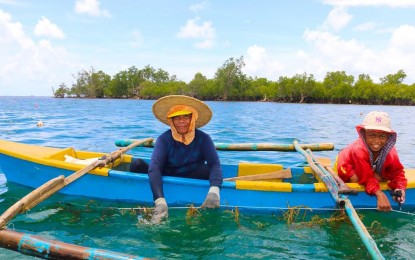
RED TIDE BLOOM. Seaweed farmers of Matarinao Bay in General Macarthur, Eastern Samar in this undated photo. The Bureau of Fisheries and Aquatic Resources on Tuesday (Aug. 31, 2021) said the red tide phenomenon remains in Matarinao Bay and four other bays in Eastern Visayas region. (Photo courtesy of FishCORAL Project)
TACLOBAN CITY – Red tide organisms have persisted in five Eastern Visayas bays as abnormal weather conditions hit several parts of the region this year.
Bureau of Fisheries and Aquatic Resources (BFAR) regional director Juan Albaladejo reported on Tuesday the prolonged dry season followed by sudden heavy rains have triggered the stay of the red tide phenomenon in several areas of the region.
“Pollutants that are fed to river systems to siltation of inner bay make it prone to red tide events as the cyst of the microorganism just hibernate in these bays with previous red tide occurrence and just waiting for a conducive condition to bloom. This is further aggravated by climate change,” Albaladejo told the Philippine News Agency (PNA).
In its latest advisory, BFAR confirmed that red tide toxins remain in Carigara Bay in Babatngon, San Miguel, Barugo, Carigara and Capoocan, in Leyte province; San Pedro Bay in Basey, Samar; Matarinao Bay in the towns of General MacArthur, Hernani, Quinapondan, and Salcedo in Eastern Samar; and seawaters of Biliran Island in Biliran province.
The official asked local government units in these bays to heighten their watch against gathering, trading, and consumption of shellfish to prevent the incidence of paralytic shellfish poisoning (PSP).
PSP occurs from ingesting bivalve shellfish (such as mussels, oysters, and clams) that contain toxins and its symptoms include tingling of the lips and tongue, which may begin within minutes of eating toxic shellfish or may take an hour or two to develop.
Symptoms may progress to tingling of fingers and toes and then loss of control of arms and legs, followed by difficulty in breathing.
Fish, squid, shrimp, and crabs harvested in these areas are safe to eat “provided that they are fresh and washed thoroughly and internal organs such as gills and intestines are removed before cooking.”
BFAR has been regularly analyzing water samples through its regional laboratory to ensure that shellfishes are safe for human consumption.
Meat samples have been sent to their national laboratory for thorough analysis.
Red tide is a term used to describe a phenomenon where the water is discolored by high algal biomass or the concentration of algae. (PNA)
